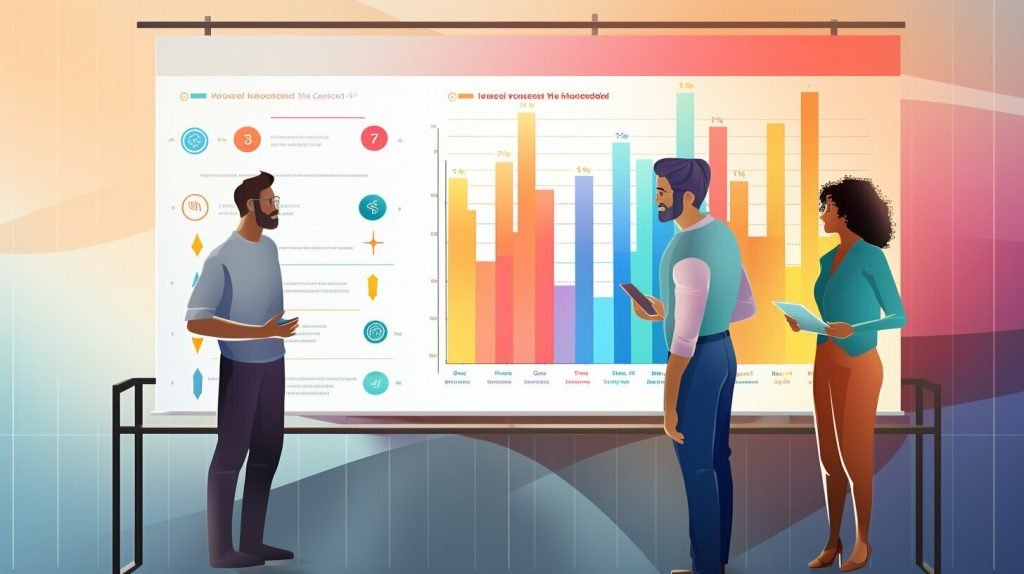Promotional strategies are an essential part of any successful marketing campaign. However, to create effective marketing messages, it is crucial to understand the target audience. Target audience analysis is the process of identifying the characteristics, behavior, and preferences of potential customers to create tailored marketing strategies that resonate with them.
This section will delve into the significance of promotional strategies and target audience analysis in marketing, exploring various marketing strategies, audience segmentation techniques, and the benefits of understanding the target audience. It will also cover essential tools and methods for conducting target audience analysis, analyzing audience behavior and preferences, and applying the findings to develop successful promotional strategies.
Key Takeaways:
- Promotional strategies are necessary for successful marketing campaigns.
- Target audience analysis is crucial in creating tailored marketing messages.
- Understanding the behavior and preferences of the target audience can improve overall promotional efforts.
Section 2: The Importance of Promotional Strategies
Promotional strategies are an essential component of any marketing campaign. They form a crucial part of marketing plans, designed to raise brand awareness, drive sales and increase revenue. Effective promotional strategies can help businesses to reach their target audience and connect with them in an impactful way, leading to greater engagement and increased loyalty.
Marketing strategies, including promotional campaigns, can take many different forms. From social media promotions to email marketing, product launches, and influencer marketing, companies have an array of tools at their disposal to spread their message and engage their target audience.
The Significance of Promotional Strategies
The primary goal of promotional strategies is to generate interest and create a buzz about a product or service. They can help establish brand identity and differentiate a company from its competitors by highlighting key features and benefits.
Effective promotional strategies can also increase brand loyalty by engaging with customers in a meaningful way. By providing targeted content and messaging, companies can create a loyal following that is more likely to return for repeat purchases.
Ultimately, a well-executed promotional strategy can help to drive sales and increase revenue. By developing a clear message and targeting the right audience, businesses can boost their bottom line while strengthening their brand.

“The aim of marketing is to know and understand the customer so well the product or service fits him and sells itself.” – Peter Drucker
Understanding Target Audience Analysis
Target audience analysis is the process of identifying and understanding the audience for a product or service. It is a crucial step in developing effective marketing strategies and executing successful promotional campaigns.
Effective audience targeting starts with defining the target audience. This may involve dividing the market into smaller segments based on demographic, geographic, psychographic, and behavioral factors. For instance, demographic factors may include age, gender, income, education, ethnicity, and occupation.

Geographic factors may include location, climate, and culture, whereas psychographic factors may include values, beliefs, personality, and lifestyle. Lastly, behavioral factors may include purchase history, product usage, and brand loyalty.
Once the target audience is defined, the next step is to analyze their needs and preferences. This may involve using various research methods such as surveys, focus groups, customer feedback, and website analytics. By gaining insights into the target audience’s needs and preferences, businesses can develop tailored marketing messages and promotional activities that resonate with their audience. Audience segmentation is an important part of target audience analysis; it involves dividing the target audience into smaller groups based on shared characteristics and needs.
Market segmentation is another technique used in target audience analysis. It involves dividing the market into smaller groups based on different criteria such as geographic, demographic, psychographic, and behavioral factors. Marketers use this information to develop targeted marketing messages and promotional activities for each segment.
The Benefits of Target Audience Analysis
Conducting target audience analysis is crucial in improving the effectiveness of promotional activities. By understanding the needs and preferences of the target audience, a marketer can customize marketing strategies and messages to suit their target audience’s interests, leading to higher engagement and better conversion rates.
Some of the key benefits of target audience analysis are:
| Benefit | Description |
|---|---|
| Improved ROI | By creating targeted campaigns, the marketer can reach the right audience, leading to higher conversion rates and ultimately better ROI. |
| Better Marketing Strategies | Target audience analysis helps to identify gaps in the current marketing strategy. Marketers can tailor their approaches to ensure that they resonate with the target audience, leading to better marketing strategies and higher engagement levels. |
Overall, target audience analysis helps to refine and improve marketing approaches, leading to better promotional activities, increased customer engagement, and ultimately better business results.
 Understanding the target audience is key in developing successful marketing campaigns.
Understanding the target audience is key in developing successful marketing campaigns.Techniques for Target Audience Analysis
Conducting target audience analysis is a crucial step in developing effective promotional strategies. By understanding the needs and preferences of the target audience, businesses can create tailored marketing campaigns that resonate with their customers.
There are various techniques and tools available for conducting target audience analysis, including:
- Social media analytics: Analyzing data from social media platforms can provide valuable insights into audience demographics, interests, and behaviors. By understanding how customers engage with a brand on social media, businesses can develop social media marketing strategies that are more effective.
- Website analytics: Analyzing website traffic data can help businesses understand how potential customers interact with their website, including which pages are most popular, how long visitors stay on the site, and what actions they take on the website. This information can be used to optimize website content and improve user experience.
- Surveys and focus groups: Surveys and focus groups can be used to directly gather feedback from customers about their needs, preferences, and opinions. This information can be used to develop targeted marketing messages and promotional campaigns.
- Branding tactics: Branding tactics, such as creating customer personas and journey maps, can help businesses better understand their target audience by visualizing their characteristics and behaviors.
Using a combination of these techniques can provide a comprehensive understanding of the target audience, leading to more effective promotional strategies.

Image source: https://seowriting.ai/32_6.png
Analyzing Audience Behavior and Preferences
One of the key steps in target audience analysis is understanding the behavior and preferences of potential customers. By gathering insights into their needs and desires, you can create tailored marketing messages and promotional activities that resonate with them.
One effective way to analyze audience behavior is through audience segmentation. This involves dividing the target market into smaller groups based on common characteristics, such as age, gender, location, or interests. By doing so, you can tailor your messaging to each specific segment, improving the chances of engaging them.
| Segment | Characteristics | Marketing Message |
|---|---|---|
| Millennials | Age: 25-40 Interests: Sustainability, Fitness, Travel | Join the movement towards a more sustainable future with our eco-friendly product line! |
| Parents | Age: 30-50 Interests: Family, Health, Convenience | Simplify mealtime for your family with our healthy and delicious pre-made meal plans! |
Another useful technique for understanding audience behavior is by conducting surveys or focus groups. These methods allow you to gather direct feedback from your target market, uncovering insights into their preferences and pain points. By analyzing this feedback, you can refine your marketing messages and tailor your promotional activities accordingly.
Finally, market segmentation can also provide useful insights into audience behavior and preferences. This involves dividing the market into groups based on their buying habits and patterns. By understanding the needs and behaviors of different segments, you can create targeted marketing campaigns that cater specifically to their preferences.

Applying Target Audience Analysis to Promotional Strategies
Once the target audience has been identified and analyzed, the next step is to apply these findings to the promotional strategies. The goal is to create customized and targeted marketing messages that resonate with the audience and inspire them to take action.
Tailoring Marketing Messages
One way to apply target audience analysis to promotional strategies is by tailoring the marketing messages to suit the audience’s preferences. This involves using language that resonates with the target audience, highlighting the benefits that matter most to them and addressing their pain points. By doing so, the marketing messages become more relatable and engaging, increasing the likelihood of conversions.
For example, if the target audience is young adults interested in fitness, the promotional message could emphasize the health benefits of the product or service and highlight how it aligns with their fitness goals. This approach resonates with their interests and values, making them more likely to engage with the campaign.
Selecting Appropriate Promotional Channels
Another way to apply target audience analysis to promotional strategies is by selecting the appropriate promotional channels. The goal is to reach the audience where they are most active and engage them through channels they prefer.
For example, if the target audience is predominantly active on social media, the promotional campaign should leverage social media channels to reach and engage the audience. This could involve creating social media posts, publishing sponsored content or partnering with influencers.
Alternatively, if the target audience is more likely to engage with email promotions, the campaign should focus on building an email list and using email marketing to reach out to the audience. In this case, the promotional activities could involve creating newsletters, personalized email campaigns, and targeted offers.
Integrating Audience Insights into Overall Marketing Strategy
Finally, target audience analysis should be integrated into overall marketing strategy. By incorporating audience insights into the marketing mix, companies can refine their promotional activities and develop more effective marketing strategies.
For example, if the target audience is highly active on social media, the company could invest more resources in social media marketing campaigns. Alternatively, if email marketing has proven to be effective in engaging the audience, the company could focus on optimizing and scaling email marketing activities.
By applying target audience analysis to promotional strategies, companies can develop customized and targeted marketing messages that resonate with the audience and inspire them to take action. This approach increases the likelihood of conversions and helps build stronger connections with the target audience.

The Importance of Measuring the Success of Promotional Strategies
Measuring the success of promotional strategies is crucial in determining the effectiveness of marketing campaigns. Without tracking the right metrics, it’s difficult to make informed decisions and optimize promotional efforts. Metrics can provide insight into audience behavior, preferences, and engagement, which can inform future marketing decisions. This section covers key metrics and analytics that can be used to assess the effectiveness of promotional strategies.
| Metric / Analytics | Description |
|---|---|
| Click-Through Rate (CTR) | CTR measures the number of clicks on a promotional link or advertisement divided by the number of impressions. It helps assess the appeal of the marketing message to the target audience and can indicate how effective it is in driving traffic to a website or landing page. |
| Conversion Rate | Conversion rate measures the percentage of website visitors who take a desired action, such as making a purchase or filling out a form. It indicates the effectiveness of the promotional strategy in driving revenue and leads, and can help identify areas for improvement in the sales funnel. |
| Engagement Rate | Engagement rate measures the level of audience interaction with promotional content, such as likes, shares, and comments on social media. It can indicate the relevance and interest of the content to the target audience, and help refine the promotional message to better appeal to them. |
| Return on Investment (ROI) | ROI measures the return on investment for a promotional campaign, taking into account the costs of media, content creation, and other expenses. It helps assess the overall effectiveness of the campaign, and determine if it was cost-effective and met business goals. |
Measuring the success of promotional strategies is an ongoing process. Continuously tracking and analyzing data can help identify trends, optimize marketing efforts, and adjust strategies based on audience feedback. It’s important to establish clear goals and objectives for the promotional campaign before measuring success, as this will guide the selection of relevant metrics and tools. By regularly monitoring the appropriate metrics, businesses can make data-driven decisions and create more effective promotional strategies.

Adjusting Promotional Strategies based on Audience Feedback
Listening to customer feedback is a crucial component of successful marketing campaigns. Tailoring promotional strategies based on audience insights can help build stronger connections with customers and improve overall campaign effectiveness. Here are some ways to adjust promotional strategies based on audience feedback:
- Pay attention to comments and reviews: Monitoring comments and reviews on social media and other platforms can provide valuable insights into customer preferences and opinions. Analyze the feedback to identify common themes and adjust promotional strategies accordingly.
- Conduct surveys: Surveys are a great way to gather detailed feedback from customers. Ask specific questions about promotional campaigns and use the responses to make data-driven decisions about future promotional strategies.
It is important to remember that promotional campaigns should never stop evolving. Continuously adjusting and refining promotional strategies based on audience feedback can help ensure long-term success.
“The biggest risk is not taking any risk. In a world that’s changing really quickly, the only strategy that is guaranteed to fail is not taking risks.” – Mark Zuckerberg
As Mark Zuckerberg notes, taking risks is an essential part of marketing success. By adapting promotional strategies based on audience feedback, businesses can take calculated risks and improve their chances of reaching their target audience effectively.
To learn more about measuring the success of promotional strategies and adjusting them based on audience feedback, continue reading the next section.

Case Studies and Examples of Successful Promotional Strategies
Real-life examples of successful promotional strategies can offer valuable insights and inspiration for businesses looking to engage their target audience effectively. Here are some noteworthy case studies:
1. Coca-Cola’s “Share a Coke” Campaign
In 2011, Coca-Cola launched a new marketing campaign called “Share a Coke” in Australia, which quickly spread and became a global phenomenon. The campaign involved personalizing Coke bottles with popular first names and encouraging consumers to share them with friends and family.
The strategy worked exceptionally well, with the company experiencing a 2% increase in sales and a 7% increase in consumption. The campaign’s hashtag, #ShareACoke, generated over 500,000 photos on social media, and the company’s Facebook page received over 25 million new “likes.”
The success of the “Share a Coke” campaign was due to its ability to connect with the target audience on a personal level, creating a sense of brand loyalty and emotional attachment.

2. Old Spice’s “The Man Your Man Could Smell Like” Campaign
Old Spice, a grooming brand for men, made a splash with its “The Man Your Man Could Smell Like” campaign in 2010. The campaign involved a series of humorous ads featuring a shirtless, confident, and humorous figure speaking to women and encouraging them to buy Old Spice products for their men.
The ads were hugely popular, generating over 40 million views on YouTube alone. The campaign was a massive success, increasing sales by 106% and attracting a younger demographic to the brand.
The success of the “The Man Your Man Could Smell Like” campaign was due to its ability to utilize humor and create a relatable character that resonated with the target audience.
3. Airbnb’s “Belong Anywhere” Campaign
In 2014, Airbnb launched the “Belong Anywhere” campaign to promote its short-term home rental service. The campaign involved a series of ads featuring people of different backgrounds and lifestyles using Airbnb to travel and connect with local communities.
The campaign was a huge success, generating over 45 million views on YouTube and increasing bookings by 25%. The “Belong Anywhere” campaign resonated with the target audience by tapping into the universal desire to travel and belong, creating an emotional connection with consumers.

These case studies demonstrate the power of effective promotional strategies that connect with the target audience on an emotional level, tap into universal desires and create a sense of personalization and community. By applying target audience analysis and tailoring marketing messages and channels, businesses can create memorable and effective promotional campaigns that drive sales and build brand loyalty.
Conclusion
Effective promotional strategies and target audience analysis are crucial components of any successful marketing campaign. By tailoring marketing messages to the needs and preferences of their target audience, companies can build stronger connections with customers, increase brand awareness, and boost sales.
It is essential to understand the target audience thoroughly to create tailored marketing strategies that resonate with them. Target audience analysis involves identifying and segmenting the market, analyzing audience behavior and preferences, and gathering insights from digital marketing and branding tactics.
Applying target audience analysis findings to promotional strategies helps create more effective marketing campaigns. By selecting appropriate promotional channels and messaging, companies can engage their target audience and improve overall promotional efforts.
Measuring the success of promotional strategies is essential for making data-driven decisions. By analyzing key metrics and audience feedback, companies can refine their marketing approaches and adjust promotional strategies accordingly.
Ultimately, the success of promotional strategies relies on understanding the target audience and applying data-driven insights to marketing campaigns. By doing so, companies can create more effective promotional strategies that drive engagement, brand loyalty, and sales.
How Can Public Relations and Media Outreach Help in Reaching the Target Audience Successfully?
Public relations and media outreach play a crucial role in implementing effective promotional strategies to reach the target audience successfully. These tactics involve crafting compelling press releases, engaging with influencers, and leveraging online platforms. By strategically targeting media outlets and utilizing various communication channels, companies can build brand visibility and credibility, ultimately increasing audience reach and engagement.
FAQ
Q: What are promotional strategies?
A: Promotional strategies are planned activities and tactics used to promote products or services to a target audience. These strategies aim to increase brand awareness, drive sales, and achieve marketing objectives.
Q: Why are promotional strategies important?
A: Promotional strategies are crucial for marketing success as they help businesses reach and engage their target audience effectively. By utilizing various marketing tactics, promotional strategies can create brand awareness, generate leads, and drive conversions.
Q: What is target audience analysis?
A: Target audience analysis is the process of identifying and understanding the characteristics, needs, preferences, and behaviors of a specific group of people who are most likely to be interested in a product or service. It involves demographic, psychographic, and behavioral segmentation to tailor marketing efforts accordingly.
Q: What are the benefits of target audience analysis?
A: Target audience analysis provides several benefits, including the ability to develop tailored marketing strategies, improve promotional activities, enhance customer satisfaction, and increase brand loyalty. It enables businesses to connect with their audience on a deeper level and deliver more relevant and personalized marketing messages.
Q: What techniques can be used for target audience analysis?
A: Various techniques and tools can be employed for target audience analysis. This includes utilizing digital marketing tactics such as social media analytics and website analytics to gather audience insights. Additionally, branding tactics can be employed to collect data on audience preferences and behaviors.
Q: How can audience behavior and preferences be analyzed?
A: Audience behavior and preferences can be analyzed through data analysis methods and techniques. This can involve tracking user interactions on websites and social media platforms, conducting surveys and interviews, and utilizing market research data. The insights gained help understand audience needs and preferences.
Q: How can target audience analysis be applied to promotional strategies?
A: Target audience analysis findings can be applied to promotional strategies by tailoring marketing messages, selecting appropriate promotional channels, and using specific tactics that resonate with the target audience. By understanding audience characteristics and preferences, businesses can create more impactful and successful promotional campaigns.
Q: How can the success of promotional strategies be measured?
A: The success of promotional strategies can be measured using key metrics and analytics. This includes tracking conversions, website traffic, engagement rates, and ROI. By analyzing these metrics, businesses can evaluate the effectiveness of their promotional efforts and make data-driven decisions.
Q: Why is it important to adjust promotional strategies based on audience feedback?
A: Adjusting promotional strategies based on audience feedback is essential to meet evolving audience needs and preferences. By listening to customer feedback and insights, businesses can refine their marketing approaches, address any issues or concerns, and build stronger connections with their target audience.
Q: Can you provide examples of successful promotional strategies?
A: Yes, real-life case studies and examples of successful promotional strategies exist. These examples showcase how companies from different industries engaged their target audience effectively through well-executed promotional campaigns. They provide insights into various marketing strategies and tactics.

